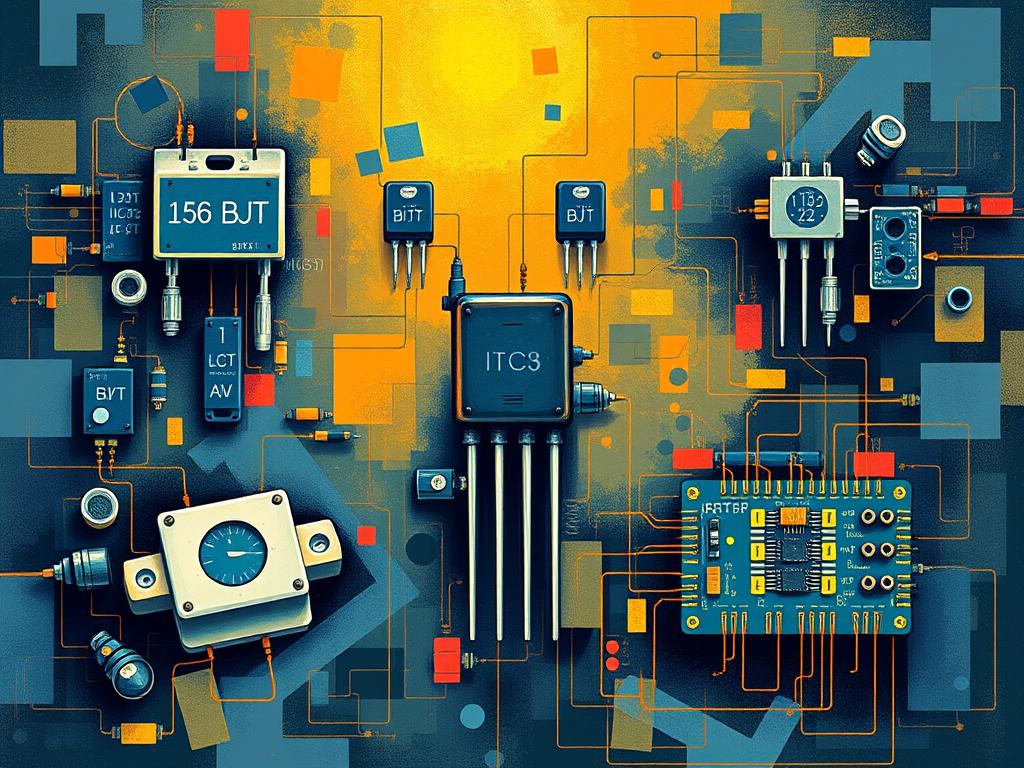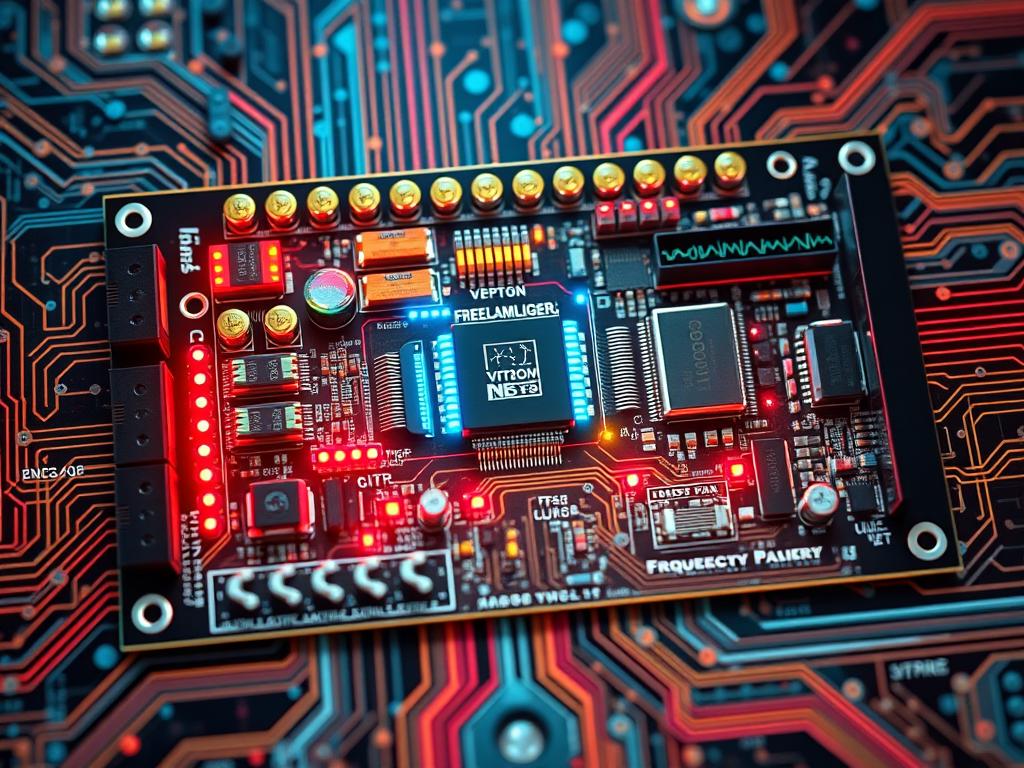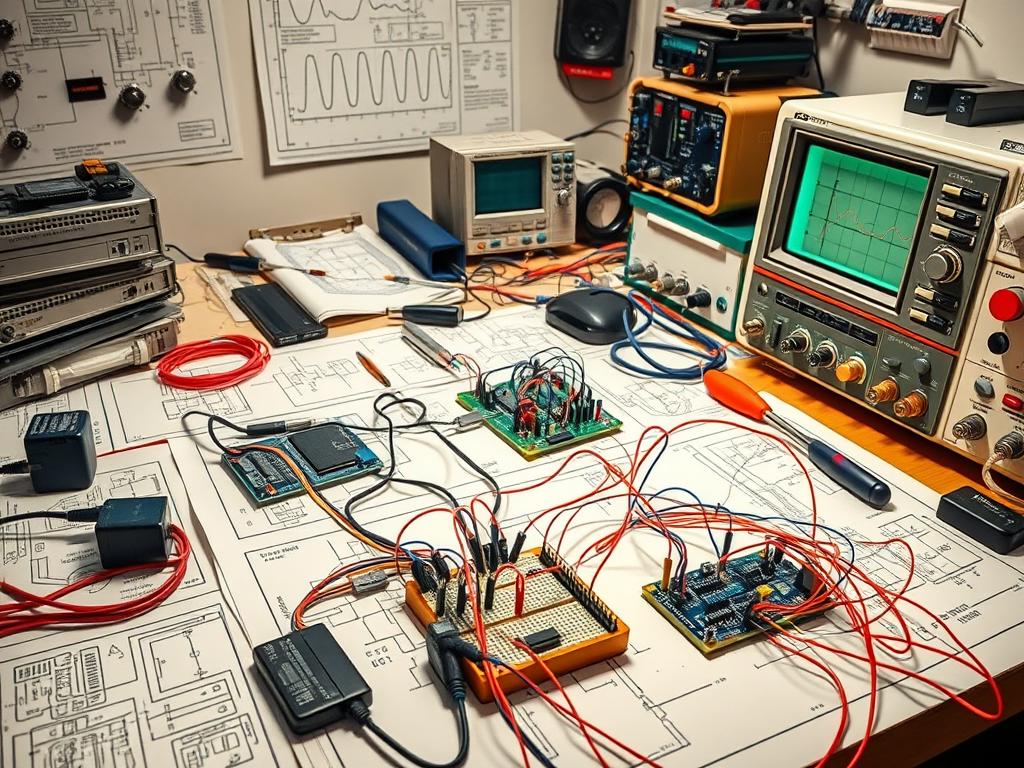Frequency multipliers are key in making electronic circuits better by turning input signals into higher frequencies. They are used in many areas, like communication systems and frequency synthesizers. They make sure the signal is clear and strong. Transistors play a big role in this, offering better performance than old methods.
Transistor-based multipliers, like Class A and Class B amplifiers, work more efficiently. Class B amplifiers can reach up to 50% efficiency. For example, YIG multipliers can take input frequencies from 1 to 2 GHz and produce outputs up to 18 GHz. New technologies, like Phase-Locked Loops (PLLs) and MEMS-based doublers, keep improving these devices. This article helps electronics experts use transistors to boost circuit performance and increase frequency.
Key Takeaways
- Frequency multipliers transform input signals into harmonics, crucial for enhancing circuit performance.
- Transistor technology offers distinct advantages over passive solutions, improving overall efficiency.
- Devices such as YIG multipliers can significantly extend output frequencies in advanced applications.
- Understanding the roles of various transistors is essential for effective circuit design.
- Advanced synthesis techniques, like PLLs and MEMS, drive the modern application of frequency multipliers.
Understanding Frequency Multipliers in Electronics
Frequency multipliers are key in electronics. They make an output frequency that’s a multiple of the input. The definition of frequency multipliers shows they’re vital in many systems and signal processing. They help make signal transmission more efficient by increasing frequencies.
What is a Frequency Multiplier?
Frequency multipliers change an input frequency into an output that’s a harmonic of it. This is crucial, especially in frequency synthesizers. They need clean, stable frequency signals.
Efficiency can vary a lot, with Class C amplifiers reaching over 50 percent efficiency. New technologies, like graphene-based FETs, have made frequency doublers over 90% efficient. These improvements show how important these devices are in electronics.
History and Development of Frequency Multipliers
The evolution of frequency multipliers has seen big steps forward. Early designs used simple diodes, but transistors have greatly improved them. Now, they use advanced methods like phase-locked loops (PLLs) and fractional-N synthesis.
For example, YIG multipliers can reach up to 18 GHz from inputs of 1 to 2 GHz. These advancements have made frequency multipliers crucial in both business and research.
The Role of Transistors in Frequency Multiplication
Transistors are key in frequency multiplication, making circuits work better. They help get high-frequency signals without losing quality. Knowing which transistors to use is crucial for those working in electronics.
Types of Transistors Used
Transistors used in frequency multipliers are chosen for their performance. The main types include:
- Bipolar Junction Transistors (BJTs): BJTs are great for high current and fast switching, making them good for RF.
- Field-Effect Transistors (FETs): FETs, especially certain types, are known for low noise and power use. Graphene FETs can work at very high frequencies.
- Schottky Diodes: Not transistors, but often used with them for efficient frequency multiplication.
How Transistors Function as Multipliers
Transistors act as multipliers by using their nonlinear operation. They create harmonics of the input signal by driving the base-emitter junctions. This can be in different modes:
- Fundamental Mode: Works at the basic frequency, making specific harmonics.
- Second Harmonic Mode: Mainly produces a frequency that’s a multiple of the input.
These modes help improve circuit design, making frequency output more efficient. For more on building electronics, check out this link.

New devices like the FeFET show progress in frequency doubling. They do this without needing extra filter circuits. This leads to more compact and efficient frequency multipliers.
| Transistor Type | Key Features | Applications |
|---|---|---|
| BJT | High current gain, fast switching | RF amplifiers, oscillators |
| FET | Low noise, low power | Low-noise amplifiers, switches |
| GFET | High frequency performance, reconfigurable | High-speed communications, signal processing |
| FeFET | Compact, energy-efficient, reconfigurable | Frequency doubling, rectification |
Key Applications of Frequency Multipliers
Frequency multipliers are key in many electronic fields. They are used in communication systems, signal processing, and testing equipment. They can turn lower frequencies into higher ones, making them very useful.
Communication Systems
In communications, frequency multipliers help create microwave frequencies. These are essential for sending and receiving signals fast. They improve data transmission by making signals stronger and wider.
Signal Processing
In signal processing, frequency multipliers work with mixers to create new frequencies. This helps in tuning and modulation of radios and other devices. For example, using IC-555 timers and OP AMP IC-741 can fine-tune signal quality.
Test Equipment
Frequency multipliers are also vital in test equipment. They help create test signals for calibrating electronic devices. This is crucial for precise measurements in systems like frequency counters and phase-locked loops. Devices like the Frequency Multiplier Using IC-555 and OP AMP IC-741 Trainer Board make testing more efficient.
Advantages of Using Frequency Multipliers
Frequency multipliers greatly improve electronic circuits. They enhance signal quality and increase operational bandwidth. These benefits are crucial in many applications.
Improved Signal Quality
Using multipliers is key for better signal quality in electronics. Transistors can multiply signals with high gain, even at high orders. The base-emitter junction creates harmonics, which the collector-emitter segment amplifies.
This results in clearer signals. Emitter decoupling capacitors with low reactance help ensure top performance. They work well across different frequencies and harmonics.
Frequency Range Expansion
Transistors help expand the frequency range in electronic devices. By using transistor multipliers, engineers can boost harmonic power. This leads to a wider operational bandwidth.
This wider range is essential for efficient communication and signal processing. It’s vital in today’s electronics. Choosing the right components, like varactor diodes, also improves efficiency. It optimizes parasitic capacitances.
It’s important to understand how frequency multipliers work. For more on transistors, check out this guide on essential transistor terminology.
| Parameter | Transistor Multipliers | Diode Multipliers |
|---|---|---|
| Maximum Multiplication Factor | High (order > 3 possible) | About 3 |
| Gain Potential | Significant Gain | Low Gain |
| Signal Clarity | Higher clarity | Moderate clarity |
| Harmonic Power | High levels | Limited levels |
Designing a Frequency Multiplier Circuit
Creating a frequency multiplier circuit needs a careful plan. It’s important to understand how to match impedance and filter harmonics. The right component selection for multipliers is key, especially for transistors and passive elements.
Basic Circuit Design Principles
At the core of good circuit design is the idea that a sine wave through a nonlinear circuit creates harmonics. To boost efficiency, focus on the right harmonics and cut down on unwanted ones. This is done through smart design methods.
- Impedance matching to ensure maximum power transfer
- Harmonic filtering to eliminate unwanted frequencies
- Utilization of specific types of circuits such as diode clipping circuits and Class C amplifiers
Selection of Components
The choice of components greatly affects a frequency multiplier circuit’s performance. Different components offer unique benefits:
| Component Type | Efficiency | Notes |
|---|---|---|
| Linear Class A Amplifiers | Up to 25% | Best suited for low distortion applications |
| Class B Amplifiers | Up to 50% | Good balance of efficiency and linearity |
| Class C Amplifiers | Exceeds 50% | Highly efficient for higher frequency operations |
| MEMS Technology | High Q | Ideal for narrow bandpass filtering |
| Graphene-Based FETs | Over 90% | Exceptional performance in frequency doubling |
MEMS devices and graphene-based solutions are becoming popular for their high efficiency.
Simulation Tools for Design
Advanced simulation tools are vital in the design process. They let engineers see how circuits work under different conditions. Design simulations help make changes before building anything. Tools like PLLs and delta sigma synthesizers are key for better frequency and less phase noise.
Challenges in Frequency Multiplier Design
Frequency multipliers are key in many electronic devices. It’s important to understand the design challenges, like nonlinearities and temperature changes. These issues can affect how well the device works.
Designers often struggle with distortion in frequency multipliers. This can make the output signal less clear. To overcome these problems, designers must carefully choose their components and set the right operating conditions.
Nonlinearities and Distortion
Components acting nonlinearly can cause distortion in frequency multipliers. This distortion can lead to unwanted frequencies that mess with the desired signal. Choosing the right nonlinear components is crucial.
Using Schottky diode frequency multipliers can help. They combine varactor and varistor nonlinearities. This affects how well the circuit works.
Temperature Variations
Changes in temperature can affect how multipliers work. The effects of temperature on multipliers can cause the output frequency to shift or become unstable. It’s important to pick components that can handle these changes well.
For example, high electron mobility transistors (HEMTs) can keep performance steady even when it’s hot. Designers need to think about these temperature issues. They should plan the circuit layout, manage heat, and choose the right components.
| Challenge | Impact | Mitigation Strategies |
|---|---|---|
| Nonlinearities | Signal distortion and harmonic interference | Use of specialized nonlinear devices, accurate modeling |
| Temperature variations | Frequency drift and performance inconsistency | Thermal management techniques, component selection |

Advanced Techniques for Frequency Multiplication
Advanced multiplication techniques have changed how frequency multipliers work. Phase-Locked Loops (PLLs) and special harmonic generation methods are key. They improve signal quality and efficiency in many areas.
Phase-Locked Loops (PLLs)
PLLs help keep frequencies stable and control signals well. They lock onto an input frequency and multiply it while keeping phase in sync. This leads to better performance, especially in precise tasks.
For example, TCXO’s can have a phase noise of -150 dBc/Hz at a 10 kHz offset from a 10 MHz carrier. This shows PLLs’ role in keeping frequencies stable. They also help reduce phase noise, which gets worse with multiplication.
Harmonic Generation Techniques
Harmonic generation uses transistors’ nonlinearity to create multiple frequencies from one. This is key for modern electronics. A single-transistor frequency multiplier works well as a doubler but not as a tripler.
For instance, a doubler can make a third harmonic about -15 dB from the original. But a tripler makes it about -7 dB. This shows why picking the right design is crucial for good harmonic output.
Using PLLs and harmonic generation methods helps engineers solve frequency multiplier design challenges. Future advancements will make frequency multiplication more efficient and reliable. For more on transistor techniques, check out this article on voltage boosters.
Evaluating the Performance of Frequency Multipliers
Understanding how well frequency multipliers work is key. We need to measure their performance accurately. This helps us see if they’re good for different uses. We use both old and new tools to get a full picture of their performance.
Measurement Techniques
To check how well multipliers work, we use special tools. These tools help us see how good the output is and if there are any problems.
- Spectrum analyzers for observing output frequency quality and harmonic content.
- Oscilloscopes to assess signal integrity and visual representation of the output waveforms.
- Power meters for measuring output power levels accurately.
These tools are crucial for figuring out how different types of multipliers work. Research shows that new ways to make frequency multipliers are getting better.
Key Performance Metrics
When we look at how well frequency multipliers do, we focus on a few important things:
- Gain: How much the signal gets amplified, showing how well the multiplier works.
- Efficiency: How much power is used compared to what’s needed, which affects energy use.
- Signal-to-noise ratio (SNR): Important for knowing how clear the signal is, which matters a lot in real-world use.
Knowing these metrics helps us make multipliers better. It lets engineers pick the best designs and materials for their projects. As GFET technology gets better, we’ll see even more improvements in how these devices work.

Practical Examples of Frequency Multipliers
Frequency multipliers are used in many electronic fields. They are key in wireless tech and radar systems. They help boost performance and ensure signals are sent reliably.
Case Studies in Wireless Technology
In frequency multipliers in wireless tech, their use is clear. The IC-555 timer and OP AMP IC-741 are examples. They offer high gain and bandwidth, improving signal processing.
Studies show these setups create higher frequency signals. This is crucial for good communication. Tools like the Frequency Multiplier Trainer Board also help in learning.
Innovations in Radar Systems
Radar innovations with multipliers are a big plus. They help radar systems generate and analyze signals better. This means they can spot targets more accurately.
This tech is important for both military and civilian use. It ensures accurate readings. Frequency multipliers also help in fixing circuit problems. They are used to make terahertz signals, but this is expensive and requires quality parts.
Future Trends in Frequency Multiplier Technology
The future of frequency multipliers looks bright with new tech on the horizon. Fields like telecommunications, aerospace, and defense need them more than ever. They’re key for high-frequency tasks and are getting smaller and more efficient for today’s gadgets.
Integration with Modern Electronics
As tech advances, frequency multipliers become a must-have in modern devices. Makers are working hard to make them smaller and better. Companies like Analog Devices and Texas Instruments are leading the way, meeting market needs.
This integration boosts device performance and keeps up with complex systems. It’s crucial for things like advanced radar and satellite communication.
Emerging Research and Development
Scientists are diving into new materials and designs to improve frequency multipliers. They’re using new tech like planar Schottky diodes for better performance. This could lead to huge leaps in remote sensing and more.
Studies show a bright future for devices needing reliable frequency multiplication. For more details, check out the frequency multipliers market report. It shows promising growth and trends.

Frequency Multipliers vs. Other Technologies
Looking at frequency multipliers and other technologies, like oscillators, shows their unique roles. Frequency multipliers boost the frequency of certain signals, key in many electronic systems. Oscillators, on the other hand, create steady waveforms but don’t change signal frequencies. This difference makes us wonder about their strengths and uses.
Comparing with Oscillators
The frequency multipliers comparison with oscillators reveals their different uses. Oscillators offer stable outputs, while multipliers excel in boosting specific frequencies. For instance, microwave multipliers can produce outputs up to 18 GHz from inputs between 1 to 2 GHz. This shows multipliers can reach higher frequencies and boost efficiency.
Advantages Over Other Multiplication Techniques
One big benefit of multipliers is their high efficiency and wide operational range. Class C amplifiers, for example, can be over 50% efficient, making them great for power and frequency multiplication. Also, using mixed-dimensional anti-ambipolar transistors can improve information density and reduce power loss.
| Feature | Frequency Multipliers | Oscillators |
|---|---|---|
| Signal Generation | Enhances frequency of input signals | Generates continuous waveforms |
| Efficiency | High (e.g., Class C amplifiers >50%) | Varies widely based on design |
| Typical Applications | Communication and signal processing | Clock generation and timing circuits |
| Advanced Technologies | Graphene and microwave multipliers | Multivalue and phase-locked oscillators |
These comparisons and new technologies make frequency multipliers crucial in today’s electronics. They open doors to new systems and advanced communication technologies.
DIY Frequency Multiplier Projects
Building DIY frequency multipliers can boost your circuit’s power. It’s a great way for electronics fans to learn by doing. This guide will walk you through the steps, common problems, and how to fix them. With this knowledge, you can make your projects work better.
Step-by-Step Project Instructions
Building a frequency multiplier starts with knowing what you need. Here’s how to make a simple voltage multiplier:
- First, get your parts: HV capacitors, diodes, and a Power Pulse Modulator like the PWM-OCmi (HV) or PWM-OCXi v3.
- Then, put the circuit together as the plans say.
- Make sure your input voltage is between 9 and 15V, and it can handle 10A.
- Choose your frequency, which should be adjustable from 0Hz to 125kHz.
- Adjust the pulse width from 0% to 100% for the best results.
- Finally, check the output to see if it works right; a good circuit can make up to 20kV AC from 12V DC.
Common Pitfalls and Solutions
When making DIY frequency multipliers, you might run into some problems:
- Insufficient Voltage: If your output is too low, check your capacitor sizes and make sure everything is connected well.
- Overheating: Keep an eye on the temperature. You might need to put the multiplier in a protective case like PVC filled with oil or epoxy resin.
- Frequency Instability: Make sure your parts are secure and adjust the modulation settings for the best performance.
- Safety Concerns: Always be careful when working with high voltages. Wear the right gear and handle things safely to avoid accidents.

| Component | Specifications | Price |
|---|---|---|
| Power Pulse Modulator – PWM-OCmi (HV) | Input range: 9-15V, 10A | $48.18 |
| Power Pulse Modulator – PWM-OCXi v3 | Input range: 9-15V, 10A | $123.63 |
| HV Spark Coil | Output: up to 15kV | $35.49 |
This guide makes building multipliers easier. Knowing how to solve common problems will make your projects better and more reliable. This way, you can use DIY frequency multipliers in many different ways.
Resources for Further Learning
To learn more about frequency multipliers, many resources are available. Books and publications offer deep insights into circuit design and transistor applications. They are great for both newbies and experienced professionals.
Recommended Books and Publications
“The Art of Electronics” by Paul Horowitz and Winfield Hill is a top pick. It covers practical and theoretical aspects of frequency multiplication. Journals also share the latest research and methods, keeping engineers up-to-date.
Online Courses and Workshops
Online platforms like Coursera and edX have courses for electronic engineers. They cover basic and advanced topics, including transistor technology and signal processing. Workshops with industry experts offer hands-on learning in frequency multiplier design.
For a deeper dive, check out articles on transition frequency. They explain key concepts for high-speed transistor design.


